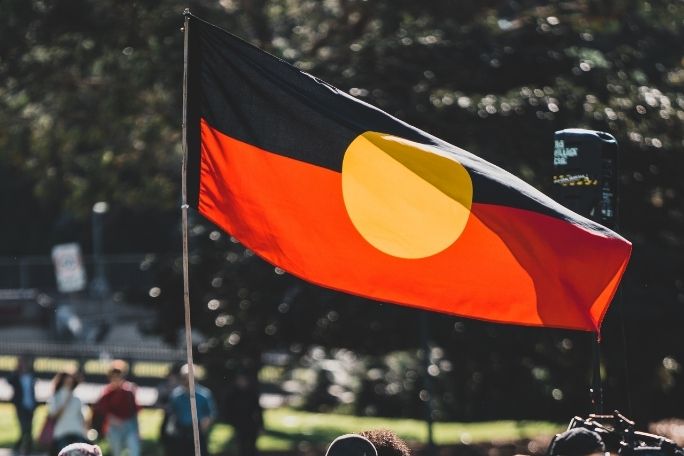Lesson summary
This lesson is based on the film Who We Are: Brave New Clan – People. Students will look at how the hosts in the film introduce themselves by referring to Country and the language of their parents and grandparents. Students then investigate the flags and language groups of Aboriginal and Torres Strait Islander people. Finally, students are asked to write a short story or personal reflection about their own family’s connection to place.
Essential questions:
- What are some of the ways that Aboriginal and Torres Strait Islander people identify themselves?
- What do Aboriginal and Torres Strait Islander flags look like and what do they mean?
- What does an Aboriginal and Torres Strait Islander languages map look like and how does it compare to other maps?
Lesson guides and printables
Lesson details
Curriculum mapping
Australian curriculum content descriptions:
Year 4 HASS:
- The diversity of Australia’s first peoples and the long and continuous connection of Aboriginal and Torres Strait Islander Peoples to Country/Place (land, sea, waterways and skies) (ACHASSK083)
- The different cultural, religious and/or social groups to which they and others in the community belong (ACHASSK093)
Year 4 English:
- Plan, draft and publish imaginative, informative and persuasive texts containing key information and supporting details for a widening range of audiences, demonstrating increasing control over text structures and language features (ACELY1694)
Year 5 English:
- Plan, draft and publish imaginative, informative and persuasive print and multimodal texts, choosing text structures, language features, images and sound appropriate to purpose and audience (ACELY1704)
Year 6 English:
- Plan, draft and publish imaginative, informative and persuasive texts, choosing and experimenting with text structures, language features, images and digital resources appropriate to purpose and audience (ACELY1714)
Syllabus outcomes: EN2-2A, EN3-2A.
Relevant parts of Year 4 HASS achievement standards: Students identify the interconnections between components of the environment and between people and the environment, and describe factors that shape a person’s identity and sense of belonging.
Relevant parts of Year 4 English achievement standards: Students create texts that show understanding of how images and detail can be used to extend key ideas, make presentations and contribute actively to class and group discussions.
Relevant parts of Year 5 English achievement standards: Students create imaginative, informative and persuasive texts for different purposes and audiences, make presentations which include multimodal elements for defined purposes, and contribute actively to class and group discussions, taking into account other perspectives.
Relevant parts of Year 6 English achievement standards: Students create detailed texts elaborating on key ideas for a range of purposes and audiences, make presentations and contribute actively to class and group discussions.
Unit of work: Who We Are: Brave New Clan – People.
Time required: 60 mins.
Level of teacher scaffolding: Medium – oversee discussion, lead students in activities.
Resources required
- Student Worksheet – one copy per student OR computers/tablets to access the online worksheet
- Device capable of presenting a website to the class
- Five sticky-notes for each group of students
- Students will need to access the AIATSIS Map of Indigenous Australia you could print copies for students or invite them to access it online
- One copy of Map of Australia – Outline for each group of students
- Device for making an audio or video recording, such as tablet or camera
Skills
This lesson is designed to build students’ competencies in the following skills:
- Critical thinking
- Collaboration
- Empathy
- Communication
- Creativity
- Cultural understanding
- Ethical understanding
- Problem solving
- Global citizenship
Additional info
This lesson is produced in partnership with Cool Australia and the Narragunnawali: Reconciliation in Education team at Reconciliation Australia.
We acknowledge and pay respect to the past, present and future Traditional Owners, Custodians and Elders of this nation and the continuation of cultural, spiritual and educational practices of Aboriginal and Torres Strait Islander peoples.
We respectfully caution Aboriginal and Torres Strait Islander peoples that this resource may contain images and names of people who have passed away.We respectfully caution Aboriginal and Torres Strait Islander peoples that this resource may contain images and names of people who have passed away.


Welcome back!
Don't have an account yet?
Log in with:
By signing up to Cool.org you consent and agree to Cool's privacy policy to
store, manage and process your personal information. To read more, please see
our privacy policy here(Opens in new tab).
Create your free Cool.org account.
Many of our resources are free, with an option to upgrade to Cool+ for premium content.
Already have an account?
Sign up with:
By signing up to Cool.org you consent and agree to Cool's privacy policy to
store, manage and process your personal information. To read more, please see
our privacy policy here(Opens in new tab).